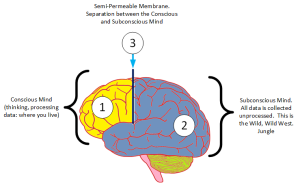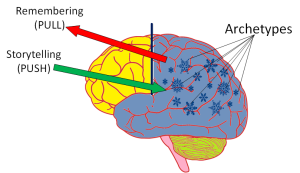by DAVID BROWN | CLEARNFO.com | July 14, 2015
On the path to deeper insights into the workings of the mind…
Now I’m no friend to psychology or psychiatry in their current incarnations; mostly because of their sorry histories and their current fraud posing as a science. I am for discovering truth that we can use productively, and I’m all for going out on a limb to discover new important information. If you want to know more on the evils of psychology and psychiatry, please see the following mental health watchdog site CCHR International. Important Note: While I do not endorse or support Scientology or any of its organizations, CCHR (Citizens Commission on Human Rights International) has produced some valuable research on psychology and psychiatry.
Some basics:
 Conscious Mind: That part of the mind that is self-aware. Has quick and current memory that is easily accessed. If I ask you your name, you don’t have to go look it up or spend a lot of time trying to remember it. If however I ask what you were doing last Wednesday at 2 p.m. you might remember or then again you might have to go look at your calendar or sit for a while until it magically came to you just exactly what you were doing. If I asked you what you were doing 10 years ago on Wednesday at 2 p.m. you might never be able to answer this unless it was a major event like a marriage, birth, graduation or funeral or if you kept meticulous notes in your diary. In any event the conscious mind is similar to the RAM in your computer. It is quick, readily accessible and limited to how many things it can hold at one time. Directly connected to the conscious Mind is the CPU or the processor that allows us to do simple logic and calculations much like our old trusty computer. So here we have a useful description of the conscious mind. It’s where we live. So the barrier between the conscious and the subconscious can be seen as a semipermeable membrane whose job it is to allow the conscious mind to focus and concentrate on the tasks at hand while the subconscious records everything verbatim and unprocessed by the analytical mind of the self-aware consciousness.
Conscious Mind: That part of the mind that is self-aware. Has quick and current memory that is easily accessed. If I ask you your name, you don’t have to go look it up or spend a lot of time trying to remember it. If however I ask what you were doing last Wednesday at 2 p.m. you might remember or then again you might have to go look at your calendar or sit for a while until it magically came to you just exactly what you were doing. If I asked you what you were doing 10 years ago on Wednesday at 2 p.m. you might never be able to answer this unless it was a major event like a marriage, birth, graduation or funeral or if you kept meticulous notes in your diary. In any event the conscious mind is similar to the RAM in your computer. It is quick, readily accessible and limited to how many things it can hold at one time. Directly connected to the conscious Mind is the CPU or the processor that allows us to do simple logic and calculations much like our old trusty computer. So here we have a useful description of the conscious mind. It’s where we live. So the barrier between the conscious and the subconscious can be seen as a semipermeable membrane whose job it is to allow the conscious mind to focus and concentrate on the tasks at hand while the subconscious records everything verbatim and unprocessed by the analytical mind of the self-aware consciousness.
 The subconscious mind: collects all data available and records it mostly unprocessed, unorganized and verbatim. It is like a jungle of unorganized raw data including recordings of all five (5) senses, including spatial, positional information and emotions. It is separated from the conscious mind by a membrane to keep the clutter out of the way so that the conscious mind can focus on specific, limited tasks and just get shit done. There are many ways of accessing the contents of the subconscious mind.
The subconscious mind: collects all data available and records it mostly unprocessed, unorganized and verbatim. It is like a jungle of unorganized raw data including recordings of all five (5) senses, including spatial, positional information and emotions. It is separated from the conscious mind by a membrane to keep the clutter out of the way so that the conscious mind can focus on specific, limited tasks and just get shit done. There are many ways of accessing the contents of the subconscious mind.
One is through the effort of trying to remember something. This would be a pull action whereby you are pulling information from the subconscious into the conscious mind. Another is with storytelling. Story telling uses archetypes which are able to penetrate the separation between the conscious and subconscious thus providing direct access to write (or push) information into the subconscious mind for a more permanent and meaningful memory. See the Joseph Campbell video below on mythology, archetypes and storytelling.
 The Semipermeable Membrane: provides the separation –think curtain– between the conscious and subconscious mind. This separation is a modern invention that allows modern man to focus on the tasks at hand and on the abstract using symbols, basic math and logic, etc. Without this separation the verbatim data recorded in the subconscious mind would flood into the conscious mind.
The Semipermeable Membrane: provides the separation –think curtain– between the conscious and subconscious mind. This separation is a modern invention that allows modern man to focus on the tasks at hand and on the abstract using symbols, basic math and logic, etc. Without this separation the verbatim data recorded in the subconscious mind would flood into the conscious mind.
So let’s see if we can apply these basic concepts and discover some useful information.
Postulate 1: When we cut our finger, the physical body goes into action to isolate the injury to prevent infection or damage to the rest of the body while it uses its power to heal. There is a scab and then when the healing completes, there may be a scar, but the body has been preserved and protected. Likewise, when we sustain severe psychic damage, the mind goes into action to isolate the injury to prevent additional damage to the rest of the mind. If the psychic damage is severe enough and if the human child is young enough the mind takes a snapshot of the entirety of the horrific insult, wraps it up enclosed in a hard case like a butterfly’s chrysalis and tucks it away somewhere in the deep recesses of the subconscious; hopefully never to be seen or heard from again. These snapshots contain everything recorded including all five senses, feelings, etc. Later, these repressed, tucked-away memories may reveal themselves when a person experiences an irrational feeling to what most would consider a minor event. This event for some reason restimulates the emotional memory, the details of which have been forgotten or tucked away in the protective chrysalis.
Postulate 2: If the child is under six years old and experiences substantial trauma, then there is great likelihood of splitting the personality into a separate partition which may arise years later when the right circumstances present themselves. This separate personality may have a different voice, personality, handwriting, etc. And can be switched into the main console of the conscious mind while the normal conscious mind is switched off. This may cause a loss of time when the normal mind switches back into charge. When there are multiple, time-separated severe psychic traumas, more splits to the personality can occur. In these cases, there may be one personality that dominates or controls the others. This personality will have its own name (Janie) and may even be referred to as an animal (Tiger). In severely split personalities this dominate personality will attempt to reconstruct a new whole personality out of the desperate parts in a desperate attempt to maintain sanity. This leads inevitably to a complete loss of what most of us think of as a self. Deep psychic damage may also result in what is termed psychosomatic transfer or illness wherein the psychic damage is converted into a physical aliment or pain.
Example 1: A man is standing on a ladder when he suddenly falls injuring his leg and is knocked unconscious. While unconscious a nearby dog is barking. Despite being unconscious, all this data is being recorded. Years later, the man discovers that despite his leg healing, it still hurts at odd times. It turns out that when a dog is barking his leg starts to hurt, but he is unable to draw the connection.
Example 2: A young girl is raped in a bathtub surrounded by small, pink tile. The event is so horrific that this memory is wrapped up nice and neatly and tucked away into the deep recesses of her subconscious as a repressed memory. Later as an adult, her husband finds her irrational hatred for small, pink tile disturbing … she has no idea why she despises small pink tile, but just has the urge to scratch it off the wall.
Conclusion: So we can see that despite the mind’s best attempt to protect itself, problems still exist only to rear their ugly head sometime in the future; sometimes causing irrational, painful and disturbing behavior apparently without explanation. These memories can have power over our lives. One way to deal with this power is to re-live these painful memories through the conscious mind so that they can be properly processed and then re-filed into the subconscious mind properly with full knowledge and analysis of the event. Freud explains this beautifully below. One caution is that if the semipermeable membrane is ever severely breached, the unprocessed jungle that is the subconscious can flood into the conscious mind causing psychosis which can be very dangerous to you and those around you.
It is common to refer to psychic injuries as being analogous to physical injuries: “There is still an open wound from when he or she betrayed me.” Or “I still need time to heal from my recent divorce before I start a new relationship.” So it makes sense to use those things familiar to us in the physical world to help describe what is going on in the emotional or psychic world. It makes for good communication where we can all understand what is going on.
Likewise, when Sigmund Freud explained the subconscious and its action of suppression at his second lecture of five on ‘The Origin and Development of Psycho-Analysis’ in 1910, he used common physical reference devices like a lecture hall and an unruly member of the audience to help communicate this novel idea…
[10] Perhaps I may give you a more vivid picture of repression and of its necessary relation to resistance, by a rough analogy derived from our actual situation at the present moment. Let us suppose that in this lecture-room and among this audience, whose exemplary quiet and attentiveness I cannot sufficiently commend, there is nevertheless someone who is causing a disturbance and whose ill-mannered laughter, chattering, and shuffling with his feet are distracting my attention from my task. I have to announce that I cannot proceed with my lecture; and thereupon three or four of you who are strong men stand up and, after a short struggle, put the interrupter outside the door. So now he is ‘repressed’, and I can continue my lecture. But in order that the interruption shall not be repeated, in case the individual who has been expelled should try to enter the room once more, the gentlemen who have put my will into effect place their chairs up against the door and thus establish a ‘resistance’ after the repression has been accomplished. If you will now translate the two localities concerned into psychical terms as the ‘conscious’ and the ‘unconscious’, you will have before you a fairly good picture of the process of repression.
[13] Our most valuable lesson from Breuer’s observation was what it proved concerning the relation between symptoms and pathogenic experiences or psychical traumas, and we must not omit now to consider these discoveries from the standpoint of the theory of repression. At first sight it really seems impossible to trace a path from repression to the formation of symptoms. Instead of giving a complicated theoretical account, I will return here to the analogy which I employed earlier for my explanation of repression. If you come to think of it, the removal of the interrupter and the posting of the guardians at the door may not mean the end [1]of the story. It may very well be that the individual who has been expelled, and who has now become embittered and reckless, will cause us further trouble. It is true that he is no longer among us; we are free from his presence, from his insulting laughter and his sotto voce comments. But in some respects, nevertheless, the repression has been unsuccessful; for now he is making an intolerable exhibition of himself outside the room, and his shouting and banging on the door with his fists interfere with my lecture even more than his bad behaviour did before. In these circumstances we could not fail to be delighted if our respected president, Dr Stanley Hall, should be willing to assume the role of mediator and peacemaker. He would have a talk with the unruly person outside and would then come to us with a request that he should be re-admitted after all: he himself would guarantee that the man would now behave better. On Dr Hall’s authority we decide to lift the repression, and peace and quiet are restored. This presents what is really no bad picture of the physician’s task in the psychoanalytic treatment of the neuroses.
[14] To put the matter more directly. The investigation of hysterical patients and of other neurotics leads us to the conclusion that their repression of the idea to which the intolerable wish is attached has been a failure. It is true that they have driven it out of consciousness and out of memory and have apparently saved themselves a large amount of unpleasure. But the repressed wishful impulse continues to exist in the unconscious. It is on the look-out for an opportunity of being activated, and when that happens it succeeds in sending into consciousness a disguised and unrecognisable substitute for what has been repressed, and to this there soon become attached the same feelings of unpleasure which it was hoped had been saved by the repression. This substitute for the repressed idea – the symptom – is proof against further attacks from the defensive ego; and in place of the short conflict an ailment now appears which is not brought to an end by the passage of time. Alongside the indication of distortion in the symptom, we can trace in it the remains of some kind of indirect resemblance to the idea that was originally repressed. The paths along which the substitution was effected can be traced in the course of the patient’s psycho-analytic treatment; and in order to bring about recovery, the symptom must be led back along the same paths and once more turned into the repressed idea. If what was repressed is brought back again into conscious mental activity – a process which presupposes the overcoming of considerable resistances – the resulting psychical conflict, which the patient had tried to avoid, can, under the physician’s guidance, reach a better outcome than was offered by repression. There are a number of such opportune solutions, which may bring the conflict and the neurosis to a happy end, and which may in certain instances be combined. The patient’s personality may be convinced that it has been wrong in rejecting the pathogenic wish and may be led into accepting it wholly or in part; or the wish itself may be directed to a higher and consequently unobjectionable aim (this is what we call its ‘sublimation’); or the rejection of the wish may be recognised as a justifiable one, but the automatic and therefore inefficient mechanism of repression may be replaced by a condemning judgement with the help of the highest human mental functions – conscious control of the wish is attained.
–S Freud, Five Lectures on Psycho-Analysis SECOND LECTURE
NOTE: YouTube removed this video: Joseph Campbell demonstrates how story telling, myths and archetypes can communicate directly to the subconsciousness for more permanent and meaningful memories. Joseph Campbell’s The Power of Myth (1/7) – The Hero’s Adventure
JOSEPH CAMPBELL AND THE POWER OF MYTH
Ep. 1: Joseph Campbell and the Power of Myth — ‘The Hero’s Adventure’
Campbell’s ‘The Power of Myth’ Notes:
Joseph John Campbell (March 26, 1904 – October 30, 1987) was an American mythologist, writer and lecturer, best known for his work in comparative mythology and comparative religion. His work is vast, covering many aspects of the human experience. His philosophy is often summarized by his phrase: “Follow your bliss. While at Dartmouth College he studied biology and mathematics, but decided that he preferred the humanities. He transferred to Columbia University, where he received a BA in English literature in 1925 and an MA in Medieval literature in 1927. Campbell studied Old French, Provençal and Sanskrit at the University of Paris in France and the University of Munich in Germany. He learned to read and speak French and German. Campbell expressed a desire to pursue the study of Sanskrit and Modern Art in addition to Medieval literature. Campbell, the great chronicler of the ‘hero’s journey’ in mythology, recognized patterns that paralleled his own thinking in one of Ricketts’s unpublished philosophical essays. Echoes of Carl Jung, Robinson Jeffers and James Joyce can be found in the work of Steinbeck and Ricketts as well as Campbell In 1934 Campbell accepted a position as professor at Sarah Lawrence College. This year had a profound influence on his thinking about Asian religion and myth, and also on the necessity for teaching comparative mythology to a larger, non-academic audience. Campbell’s ideas regarding myth and its relation to the human psyche are dependent in part on the pioneering work of Sigmund Freud, but in particular on the work of Carl Jung, whose studies of human psychology greatly influenced Campbell. Campbell’s concept of monomyth (one myth) refers to the theory that sees all mythic narratives as variations of a single great story. The theory is based on the observation that a common pattern exists beneath the narrative elements of most great myths, regardless of their origin or time of creation. Campbell often referred to the ideas of Adolf Bastian and his distinction between what he called “folk” and “elementary” ideas, the latter referring to the prime matter of monomyth while the former to the multitude of local forms the myth takes in order to remain an up-to-date carrier of sacred meanings. A Hero’s Journey, he explains God in terms of a metaphor: God is a metaphor for a mystery that absolutely transcends all human categories of thought, even the categories of being and non-being.
Quotes from Joseph Campbell
– The privilege of a lifetime is being who you are
– We must let go of the life we have planned, so as to accept the one that is waiting for us
– A hero is someone who has given his or her life to something bigger than ourself
– Follow your bliss and the universe will open doors where there were only walls
– I don’t believe people are looking for the meaning of life as much as they are looking for the experience of being alive.
– It is by going down into the abyss that we recover the treasures of life. Where you stumble, there lies your treasure
– The goal of life is to make your heartbeat match the beat of the universe, to match your nature with Nature
– Life has no meaning. Each of us has meaning and we bring it to life. It is a waste to be asking the question when you are the answer
– Your sacred space is where you can find yourself again and again
– Every religion is true one way or another. It is true when understood metaphorically. But when it gets stuck in its own metaphors, interpreting them as facts, then you are in trouble
– Participate joyfully in the sorrows of the world. We cannot cure the world of sorrows, but we can choose to live in joy.
– What each must seek in his life never was on land or sea. It is something out of his own unique potentiality for experience, something that never has been and never could have been experienced by anyone else
– Myths are public dreams, dreams are private myths
– We’re so engaged in doing things to achieve purposes of outer value that we forget the inner value, the rapture that is associated with being alive, is what it is all about
– God is a metaphor for that which transcends all levels of intellectual thought. It’s as simple as that
– Opportunities to find deeper powers within ourselves come when life seems most challenging
– If the path before you is clear, you’re probably on someone else’s
– The demon that you can swallow gives you it’s power, and the greater life’s pain, the greater life’s reply
– The question is whether you are going to say a heartly yes to your adventure
– All the gods, all the heavens, all the hells, are within you
– The cave you fear to enter holds the treasures you seek
– If you are falling…. dive! Find a place inside where there’s joy, and the joy will burn out the pain
Additional reading material:
The Greenbaum Speech Hypnosis in MPD: Ritual Abuse 1992 from Cassiopaea Website Also at Rense
Psychology & the separation of the conscious and subconscious
Freud and Steiner were contemporaries:
– Sigismund Schlomo Freud; 6 May 1856 – 23 September 1939 (83 years)
– Rudolf Steiner: 27 February 1861 to 30 March 1925 (64 years)
Our Connection with the Elemental World (Steiner)
Observations on Psychology – the separation of the conscious and subconscious and Meet Rudolf Steiner (ClearNFO)
See also:
Temple of Set
Michael Aquino
Presidio San Francisco
MK Ultra and Monarch Programming
For more on Archetypes see: Carl Gustav Jung on Archetypes and Carol Pearson’s the ‘
Additional reading from ClearNFO:
Tavistock Institute: Social Engineering the Masses
MK-ULTRA, Monarch & Paperclip




